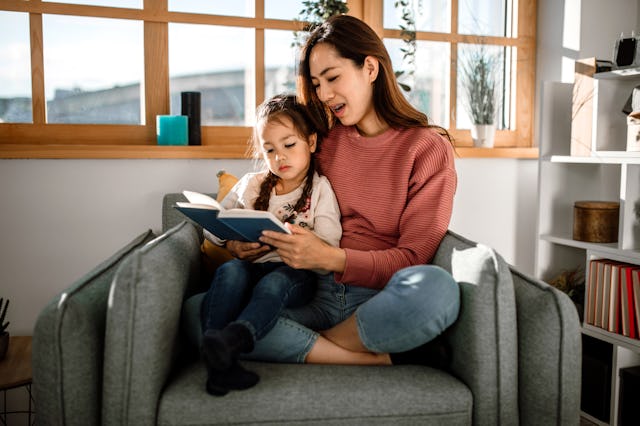What Level Of Reading Should My First Grader Be At? A First-Grade Educator’s Advice
Not all learning-to-read journeys are the same, but these tips can help.

Got a little one making the transition from kindergarten to first grade this fall? It's a big step that will come with new learning milestones — reading independently being one of them. While they may not be ready to dive into the Harry Potter series just yet, this is the age where you might see them reading to themselves... or you! And you might also be wondering what level of reading a first grader should be at. This insider look at how a first-grade reading level is assessed in the classroom and what you can do at home to support your child's reading goals will help take the guesswork out of early literacy.
According to first-grade educator Minnie Phai, "For many districts, [...] a child's reading level is determined by doing a ‘running record.’ This is when a teacher reads a book with a student and records how they read, what their strengths are as readers, what strategies they use to decode unknown words, and their comprehension skills. A child's independent reading level is then narrowed down and matched to a corresponding grade level. The most commonly used running record system is Fountas & Pinnell."
First Grade Reading Levels
Many publishers also categorize books into "Levels" that correspond to the average reading abilities of children, including some of the "Big Five" like Random House and Harper Collins, making it easier for parents to choose books appropriate for their child's grade and age. And first-grade reading levels typically correspond with Levels 1 and 2.
"Once [children] are reading these Level 1 and Level 2 books independently (with little to no help from adults, with very high or perfect accuracy), what you're hearing is children decoding all the words with greater ease and confidence. For some children, this is when they're left to read on their own or tasked with reading to their grown-up or a sibling," says Phai.
First-Grade Reading Level Examples
Curious exactly what Level 1 and Level 2 books look like? The following are classic examples:
- Go, Dog, Go! by P.D. Eastman (Level 1)
- Don’t Let the Pigeon Drive the Bus! by Mo Willems
- Ten Apples Up On Top by Dr. Seuss (Level 1)
- Garden Day! by Candice Ransom (Level 1)
- A Pig, A Fox, And Stinky Socks by Jonathan Fenske (Level 2)
- The Bookstore Ghost by Barbara Maitland (Level 2)
- Richard Scarry’s Be Careful, Mr. Frumble! by Richard Scarry (Level 2)
Encouraging a First-Grade Reader
If your child is showing signs of independent reading at Levels 1 and 2, congratulations! You're off the hook for storytime, and your child will now also be responsible for teaching any younger kids in your home or in your neighborhood to read! OK, so maybe that's a stretch. But it is a great opportunity to celebrate your child's achievements and also a reminder to check in often with their reading comprehension, fluency, and stamina — encouraging and supporting their learning to read journey.
Phai says, "This may be as simple as taking note of it, such as noticing how long their child can read for before they become fatigued, or how they are able to read in a phrased and expressive way. It can also be as involved as helping [them] differentiate character voices from narrator voices, or making inferences together like guessing what the character is feeling or thinking and why they might be feeling that way." If this sounds a little advanced for first grade, Phai points out that these less obvious skills are absolutely necessary for progressing to reading more complex texts.
Of course, every parent knows that getting their kids to do something they don't want to do can feel like pulling teeth. Your best bet is to find ways to make reading feel as comfortable and engaging as possible for your reluctant reader. A few ideas might include:
- Create a cozy reading nook.
- Take a trip to the library and let your kids pick out their favorite books.
- Encourage your kids to act out a play based on the books they are reading.
- Make connections between the characters in the books and real life.
- Be a reading role model and show your kids how excited you are about reading.
- Let your kid read aloud to you.
Now that you know what you might expect from your first-grader in terms of reading and how to support them, keep in mind that not every child is going to be excited about reading (ahem, remember that book that sat untouched on your nightstand for three months?). But making reading fun with these tips will definitely go a long way toward encouraging your first grader's love of reading!
Sight Words for First Graders
- after
- all
- and
- as
- at
- be
- big
- but
- can’t
- car
- come
- could
- day
- did
- do
- for
- form
- from
- fun
- give
- had
- have
- her
- his
- how
- if
- like
- look
- make
- many
- my
- new
- not
- now
- number
- numerals
- of
- on
- or
- our
- out
- play
- run
- saw
- should
- that
- their
- these
- this
- this
- us
- want
- was
- we
- went
- what
- when
- which
- would
- your
This article was originally published on